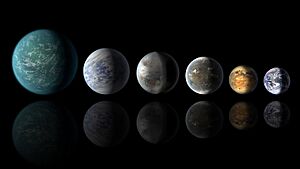Extrasolar object facts for kids
Have you ever looked up at the night sky and wondered what's out there, far beyond our own planets? An extrasolar object is any object in space that exists outside our Solar System. The name comes from Latin: extra means "outside," and solaris means "of the Sun". So, it literally means "beyond the Sun"!
This term is used for objects like planets, moons, and comets that belong to other star systems. It isn't used for the stars themselves or for even bigger things like a galaxy.
Contents
Exploring Worlds Beyond Our Sun
Scientists have discovered thousands of amazing objects orbiting distant stars. These discoveries help us understand if our Solar System is unique or if there are many others like it in the universe. Let's look at the different types of extrasolar objects.
Exoplanets: Planets Around Other Stars
The most famous type of extrasolar object is an extrasolar planet, usually called an exoplanet. These are planets that orbit a star other than our Sun.
Since the first exoplanets were confirmed in the 1990s, astronomers have found more than 5,000 of them! They come in all shapes and sizes. Some are huge gas giants, even bigger than Jupiter, while others are small, rocky worlds that could be similar to Earth.
Exomoons: Moons of Other Worlds
Just like the planets in our Solar System have moons, scientists believe that exoplanets do too. An extrasolar moon, or exomoon, is a moon that orbits an exoplanet.
Finding exomoons is very difficult because they are much smaller and dimmer than the planets they orbit. Astronomers are actively searching for them, and while they have found some possible candidates, confirming an exomoon's existence is a huge challenge.
Exocomets and Exoasteroids
Our Solar System is filled with leftover bits of rock and ice from when the planets formed. It turns out that other star systems have these too!
- An exocomet is a comet that exists outside our Solar System. Like the comets we know, they are made of ice, dust, and rock. When they get close to their star, the ice can turn to gas and create a glowing tail.
- An exoasteroid is an asteroid found in another star system. These are rocky or metallic objects, much like the asteroids in the belt between Mars and Jupiter in our own Solar System.
What Haven't We Found Yet?
While we have found many exciting objects, there are still some types we haven't spotted in other star systems. For example, astronomers have not yet confirmed the discovery of:
- Minor planets
- Dwarf planets (like Pluto)
- Trans-Neptunian objects (icy bodies that orbit far from their star)
This doesn't mean they don't exist! It just means they are very small and far away, which makes them incredibly hard to see with our current telescopes and technology.
See also
- Extraterrestrial, a term for things that are from our Solar System, but not from Earth.
- Extragalactic astronomy, the study of objects outside our own Milky Way Galaxy.
- Interstellar object, an object that has traveled through the space between stars, like the famous ʻOumuamua.
- List of artificial objects leaving the Solar System, a list of human-made spacecraft that are traveling out of the Solar System.
- Planetary system, a set of objects like planets and moons that are held by gravity in orbit around a star.
- Substellar object, an object that is too small to be a star but bigger than a planet.


